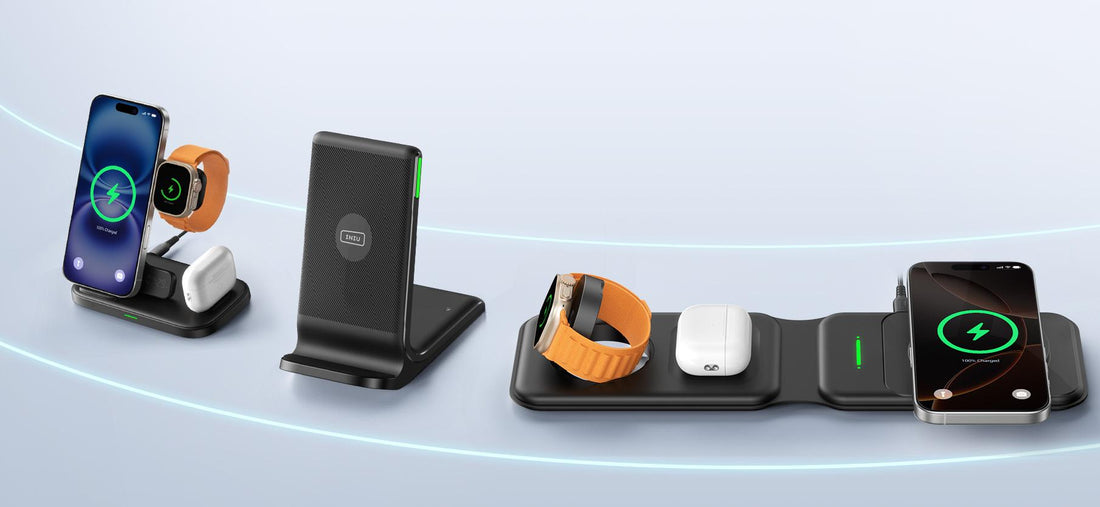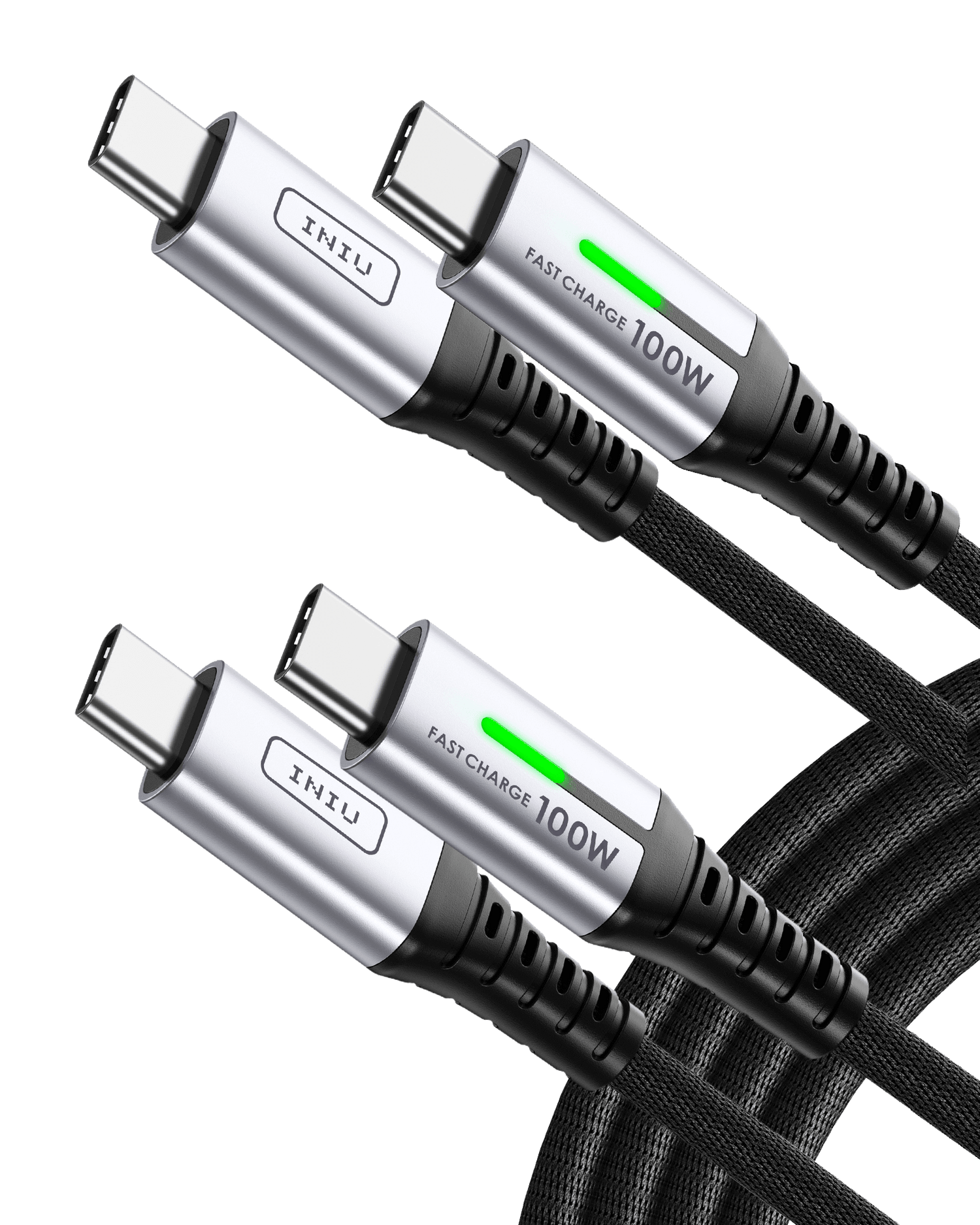
Wireless Charging: Everything You Need to Know
Wireless charging means no more tangled cords. A wireless charger sends power through the air to your phone or earbuds. It's quiet, simple, and works with more devices than ever.
What Exactly Is Wireless Charging?
A wireless charger uses electromagnetic coils to send power. It connects to a wall outlet, then transfers energy to a phone placed on top.
How Do Wireless Chargers Work Simply?
The base unit is called a wireless charging pad. It sends a magnetic field. The phone turns that field into electricity. To work, both the pad and the phone need the same standard, like a Qi wireless charger.
Qi vs MagSafe vs Qi2 Chargers Compared
Qi Wireless Charger
The Qi wireless charger is a universal, open standard created by the Wireless Power Consortium. It dates back to 2010 and supports many phone brands. Modern versions deliver up to 15 W to compatible devices.
Strengths:
- Broad compatibility (Apple, Samsung, Google, Huawei, and more).
- Reliable charging speed of 5–15 W, depending on device and charger.
- No magnets needed.
Limitations:
- Requires precise coil alignment.
- Charging efficiency is lower (70–90%), and heat can be a factor.
MagSafe
Apple introduced MagSafe in 2020 with the iPhone 12. It uses magnets to snap the phone into the perfect position and charges at up to 15 W on iPhones 12–15.
Benefits:
- Faster than basic Qi—tests found ~30 minutes faster than a 7.5 W Qi pad.
- Less heat due to magnetic alignment.
Downside:
Mostly limited to the Apple ecosystem. Non-iPhones get slower charging (e.g., 7.5 W).
Qi2
Qi2 is the newest version of Qi, released in 2023. It brings magnetic alignment like MagSafe but remains an open standard.
It delivers up to 15 W to any Qi2-certified phone. Apple helped develop this via the Magnetic Power Profile (MPP).
Advantages:
- Magnetic ring ensures easy alignment and efficient power transfer.
- Works with both iPhones and Android phones (For Android phones, magnetic alignment generally requires a compatible magnetic case or ring accessory).
- Qi2 chargers often cost less than MagSafe chargers and offer broader device support.
- Maintains backward compatibility with Qi devices, but without magnets those charge at standard Qi speeds (5–10 W).
- Qi2 simplifies charging across different brands by using a shared protocol, not just magnetic alignment.
Side‑by‑Side Quick Comparison
| Feature | Qi | MagSafe | Qi2 |
| Compatibility | Wide | Apple only (best for iPhones) | iPhone: native / Android: via accessories |
| Magnetic alignment | No | Yes | Yes |
| Peak power | Up to 15 W | 15 W (iPhone 12–15) | 15 W |
| Efficiency & heat | Lower (60–75%) | Better (due to alignment) | Similar to MagSafe |
| Cost & ecosystem | Many options | Higher, Apple licensed | Mid-range, open standard |
Is Wireless Charging Bad for Battery Life?
Using a wireless charging pad every day will not harm your battery if the phone stays cool. Heat affects batteries more than charging style. Most certified Qi wireless chargers from trusted brands automatically stop charging at 100%, helping prevent overheating and improving safety.
Wireless Charging Distance Myths Busted
A common claim suggests phones can charge across the room. In real-world use, that is false. Inductive wireless charging (Qi) demands close contact—often within 1–5 mm between coils—for energy to flow efficiently. Even a thick phone case can hamper energy transfer by adding just a few millimeters of distance.
Technology like Qi has been evolving. Some magnetic‑resonance systems can stretch the range to 40 mm or more—but only at low power (around 5 W) and with special hardware under surfaces. For typical wireless charging pad use, even a few millimeters off alignment stops charging or dramatically slows it.
Magnets or well‑designed coil placement help ensure coils align correctly every time. That improves speed, efficiency, and warmth control.
Qi2 takes this further by introducing a standardized magnetic alignment system, significantly improving precision and power transfer efficiency across certified devices.

Which Devices Support Wireless Charging?
Most modern devices use Qi. Phones, watches, earbuds—they often include a receiver coil. Many mainstream brands support Qi wireless charging:
- Apple: iPhone 8 and newer support Qi. iPhone 12 onward can use MagSafe or Qi2.
- Samsung: Samsung Galaxy flagships support Qi wireless charging; magnetic cases can enhance alignment with Qi2/MagSafe chargers, though native Qi2 support is pending.
- Google Pixel: All models from Pixel 3 include wireless charging (Some Pixel A series models, such as the Pixel 4a and 6a, do not support wireless charging).
- OnePlus, Huawei, LG, and others include Qi in premium models.
- AirPods, AirPods Pro, and some new Google Pixel Buds include Qi cases.
- Smartwatches and fitness bands from Apple, Samsung, and OnePlus also often offer wireless charging.
If a device is labelled Qi-enabled, it will work with any certified Qi wireless charging pad, regardless of brand.
Picking the Best Wireless Charger for You
Wireless Charging Pad Choices
When choosing a wireless charging pad, key factors include power output, certification, alignment, and device support:
- Look for Qi-certified pads offering at least 10 W output for faster top-ups.
- Choose between flat mats or stand-style pads. Stands allow easy phone use during charging.
- For those charging iPhones (12+), magnetic pads that support Qi2 help align coils and control heat.
- Some pads offer multi-device support—ideal for charging phone, earbuds, and watch simultaneously.
- Budget pads are available, but may deliver slower speeds (5–7.5 W) and weaker alignment features.
Need a Wireless Portable Charger?
A wireless portable charger is a power bank that adds a Qi coil. Those are great for travel:
- A minimum 5,000 mAh capacity can recharge a phone at least once.
- Many models offer 10,000 mAh to support multiple charges.
- Look for pass‑through charging to charge the bank and phone at once.
- Choose Qi2 or MagSafe-compatible banks for magnetic alignment with modern phones.
- Some fold flat or include a kickstand for stand mode at work or hotel.

How to Use Your Wireless Charger Easily
- Connect the pad to the proper adapter: Use a high-quality wall adapter sized for your wireless pad (e.g., 10–15 W). Apple Support notes Qi-certified pads need the adapter the maker recommends for best speed and reliability.
- Place the pad on a hard, flat surface: A firm, level surface helps keep coils aligned and prevents heat trapping. Experts warn that soft surfaces like beds or pillows can trap heat and slow charging.
- Center the device neatly on the pad: Place your phone or earbuds straight on the pad's center. Misalignment can halt power transfer. Apple advises centering for best charging.
- Use a thin, non-metal case: Thick plastic or metal cases block induction. Q-coil systems stress thin, non-metal back covers to ensure good contact.
- Remove metal accessories and foreign items: Items like coins, credit cards, or metallic rings can trigger Foreign Object Detection, halting charging. Auto-stop prevents heat buildup.
- Monitor device temperature: Slight warmth is normal. Many pads include heat-sensing circuits that slow charging above safe thresholds.
- Clean the pad and device underside regularly: Dust weakens the magnetic field and may cause inefficiency or excess warmth. Wipe with a soft cloth from time to time.
- Avoid charging overnight unnecessarily: Though safety systems often stop charging at 100%, extended contact can keep the system active and warm. Unplug when charging is complete.
- Unplug the charger when idle: Removing the pad from power saves energy and avoids idle heat.
Final Thoughts: Is It Time to Go Wireless?
A wireless charger makes your life easier. No cables, no wear on ports. Use a Qi wireless charger for full safety and wide compatibility. A good wireless charging pad or wireless portable charger fits daily needs at home, at work, or on the go.

FAQs about Wireless Charging
Q1: Can any phone use a Qi wireless charger?
A: No. Only phones with built-in Qi technology can receive power from a Qi wireless charger. If your phone doesn't support Qi, the wireless charging pad won't transfer energy. Some older phones may work with special receiver cases or charging patches, but the experience is less stable. To check, look for the "Qi-certified" label in the device specs or on the official website of your phone's brand.
Q2: What's the best phone case for wireless charging?
A: A thin plastic or silicone case works best. The Qi wireless charging pad needs to be close to the phone's coil, and thick or metal cases block that. Some magnetic cases are safe, especially for MagSafe or Qi2 phones, but third-party magnets can misalign coils and reduce charging speed. If in doubt, test your case on a Qi wireless charger. For iPhone 12 and newer, certified MagSafe or Qi2 cases usually allow full-speed charging without removal.
Q3: Can a wireless portable charger power two phones at once?
A: Yes, some models can. A good wireless portable charger often supports one device on the charging pad and another through a USB port. Look for power banks with at least 10,000 mAh if you plan to charge two phones. Brands now offer models with both Qi wireless charging and USB-C fast output. Keep in mind that charging two devices at once may reduce the speed for each.
Q4: Is a wireless charging pad faster than a cable?
A: Usually not. Most wireless charging pads offer 10 to 15 watts. Standard cables often deliver 20 watts or more, especially with USB-C or proprietary fast charging. But a Qi wireless charging pad is more convenient for overnight or desktop use. It also protects your phone's charging port from daily wear. Some users accept slightly slower speeds in exchange for ease. The choice between wireless and wired charging ultimately depends on prioritizing speed versus convenience.
Q5: What is the real difference between Qi and Qi2?
A: Qi2 is the updated version of the Qi standard. New version of Qi and Q2 support up to 15W charging, but Qi2 wireless chargers include built-in magnets. These magnets help align the phone with the pad, which improves speed and reduces energy loss from misalignment. Qi2 is based on Apple's MagSafe tech but works with both Android and iOS if the device supports the Qi2 profile. For phones that don't support Qi2, a Qi2 charger still works, but only at regular Qi




